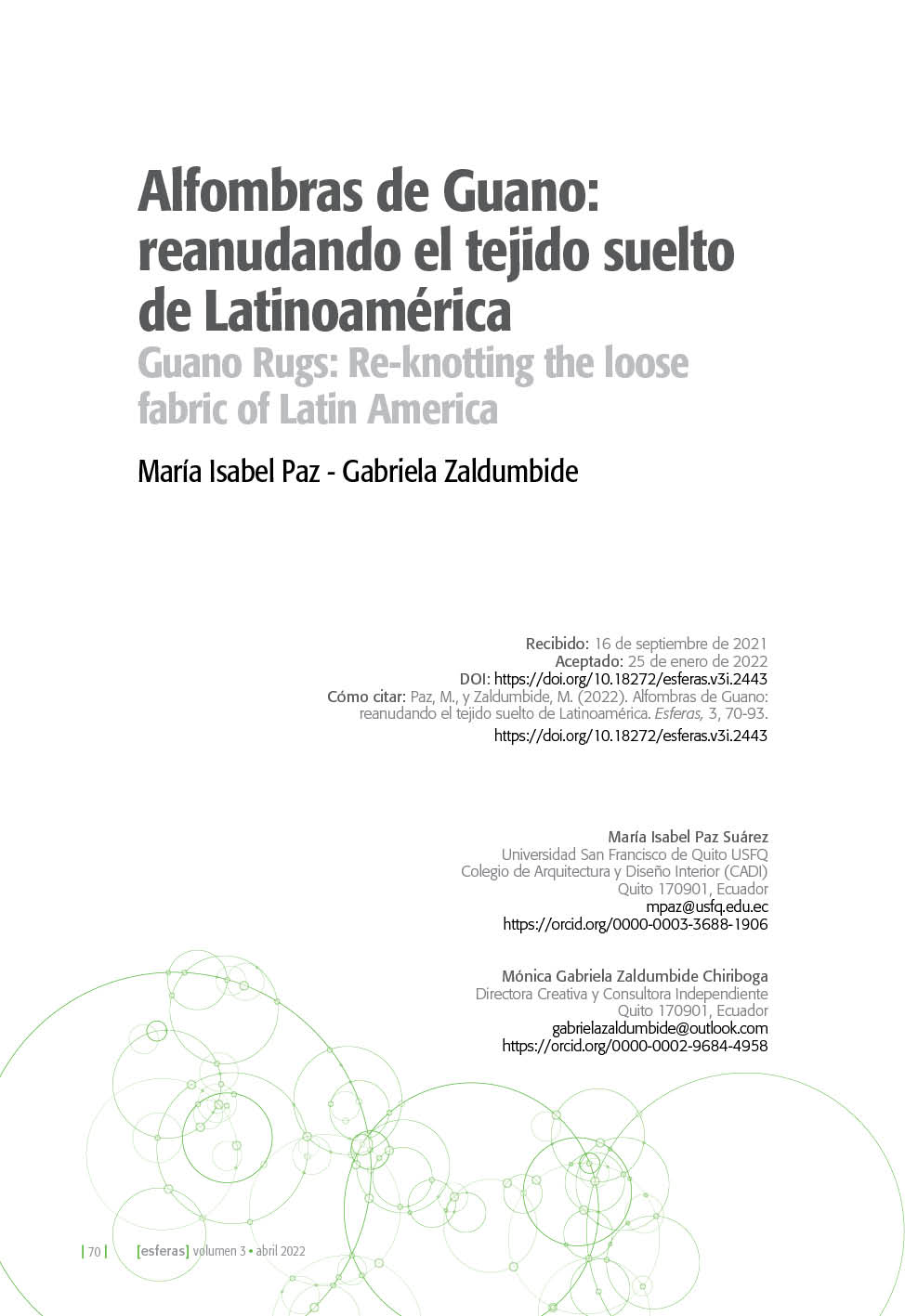Guano Rugs: Re-knotting the loose fabric of Latin America

Published 2022-04-04 — Updated on 2023-02-02
Versions
- 2023-02-02 (2)
- 2022-04-04 (1)
Keywords
- Tradition,
- craftsmanship,
- identity,
- culture,
- heritage
- artisans,
- preservation,
- Guano,
- artisanal extinction ...More
How to Cite
Copyright (c) 2022 María Isabel Paz Suárez, Mónica Gabriela Zaldumbide Chiriboga

This work is licensed under a Creative Commons Attribution-NonCommercial 4.0 International License.
Abstract
Craftsmanship is one of the most representative expressions of the intangible heritage of Latin America and the world. However, the advancement of globalization, rise of mass industries and neglect on the part of local consumers have left artisans and their traditional activities helpless. For this reason, despite incentives and assistance, many artisans in the region are facing an imminent artisanal extinction.
This research generates a journey through the history, importance and decline of handicrafts in Latin America in order to understand the cultural and economic values of preserving them. Now that current markets are again valuing manual and personalized work, the case study of the Guano knotted rugs is used to generate three main axes"”associativity, education and connectivity"”to explain the feasibility of promoting Latin American handicrafts in the world. The confrontation of the past of craftsmanship with a better tomorrow explains how the rescue of our artisans can really contribute to us all as a society and, furthermore, push towards the fulfillment of the United Nation"™s SDG to create more sustainable communities and a better future for all.
Downloads
References
- Allauca, A. (2020). Entrevista virtual. 19 de noviembre de 2020.
- Allauca, F. (2021). Entrevista presencial. 10 de septiembre de 2021.
- The New York Times. (2015, 9 de septiembre). Defining Luxury for a Modern Era. https://www.nytimes.com/2015/03/27/fashion/in-craftsmanship-defining-luxury-for-a-modern-era.html
- Harper"™s Bazaar. (2020, 4 de julio). El lujo artesano: el prestigio de la etiqueta "Made in Spain". https://www.harpersbazaar.com/es/moda/noticias-moda/a33077797/talleres-artesania-espana-lujo-industria/
- Fuchs, C. (2015). The Handmade Effect: What"™s Love Got To Do With It? Journal of Marketing. https://doi.org/10.1509/jm.14.0018
- Global Market Trajectory & Analytics. (2020). Carpets and Rugs. Global Industry Analytics Inc. https://www.researchandmarkets.com/
- Instituto Nacional de Patrimonio Cultural. (2019). Artesanos tejedores de alfombras de Guano recibirán certificación de Patrimonio Cultural Inmaterial. Gobierno de la República del Ecuador. https://www.patrimoniocultural.gob.ec/artesanos-tejedores-de-alfombras-de-guano-recibiran-certificacion-de-patrimonio-cultural-inmaterial/
- Ministerio de Turismo. (2019). Ecuador celebra el Día Nacional del Patrimonio Cultural. Gobierno de la República del Ecuador. https://www.turismo.gob.ec/ecuador-celebra-el-dia-nacional-del-patrimonio-cultural/
- Mori, T. (2005). Textile/Tectonic: Architecture, Material, and Fabrication Paperback. George Braziller.
- Organización de las Naciones Unidas. (2012). Base de datos estadísticos sobre comercio. http://data.un.org/browse.aspx?d=ComTrade
- Organización de las Naciones Unidas. (2015). Objetivos de Desarrollo Sostenible. Ciudades - Desarrollo Sostenible. https://www.un.org/sustainabledevelopment/es/education/
- Organización de las Naciones Unidas para la Educación, la Ciencia y la Cultura. (2021). Técnicas Artesanales Tradicionales. https://ich.unesco.org/es/tecnicas-artesanales-tradicionales-00057
- Organización de las Naciones Unidas para la Educación, la Ciencia y la Cultura. (2021). Patrimonio Cultural. https://es.unesco.org/fieldoffice/santiago/cultura/patrimonio
- Ortiz Arellano, C. (1995). Guano Presente y Pasado. En lo artesanal (p. 114). Edicentro.
- Paz Suárez, M.I., y Zaldumbide Chiriboga, M. G. (2021). Alfombras de Guano: salvando nuestra herencia cultural. Esferas 2 (1), 134-159. https://doi.org/10.18272/esferas.v2i.1966
- Criterio Noticias. (2018, 20 de marzo). Profesionalización de los artesanos: preservar, conservar y valorar. https://criterionoticias.wordpress.com/2018/03/20/profesionalizacion-de-los-artesanos-preservar-conservar-y-valorar/
- El Universo. (2020, 8 de septiembre). Quito celebra 42 años de ser declarada Patrimonio Cultural de la Humanidad por la Unesco. https://www.eluniverso.com/noticias/2020/09/08/nota/7970803/quito-celebra-42-anos-ser-declarada-patrimonio-cultural-humanidad/
- Rosales, R. (1997). La asociatividad como estrategia de fortalecimiento de las Pymes. Sela.
- Turok Wallace, M. (2013). Análisis social de los artesanos y artesanas en Latinoamérica. Revista Artesanías de América, 22-29. CIDAP.
